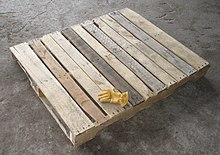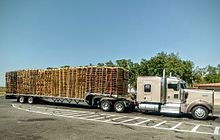
Back ሰሌዳ Amharic طبلية Arabic Pallet Azerbaijani Палет Bulgarian Palet Catalan Transportní paleta Czech Palle Danish Transportpalette German Paledo Esperanto Palé Spanish






A pallet (also called a skid) is a flat transport structure, which supports goods in a stable fashion while being lifted by a forklift, a pallet jack, a front loader, a jacking device, or an erect crane. Many pallets can handle a load of 1,000 kg (2,200 lb). While most pallets are wooden, pallets can also be made of plastic, metal, paper, and recycled materials.
A pallet is the structural foundation of a unit load, which allows handling and storage efficiencies. Goods in shipping containers are often placed on a pallet secured with strapping, stretch wrap or shrink wrap and shipped. In addition, pallet collars can be used to support and protect items shipped and stored on pallets.
Containerization for transport has spurred the use of pallets because shipping containers have the smooth, level surfaces needed for easy pallet movement. Since its invention in the twentieth century, its use has dramatically supplanted older forms of crating like the wooden box and the wooden barrel, as it works well with modern packaging like corrugated boxes and intermodal containers commonly used for bulk shipping. In 2020 about half a billion pallets are made each year and about two billion pallets are in use across the United States alone.[1] Organizations using standard pallets for loading and unloading can have much lower costs for handling and storage, with faster material movement than businesses that do not. The exceptions are establishments that move small items such as jewelry or large items such as cars. But even they can be improved. For instance, the distributors of costume jewelry normally use pallets in their warehouses and car manufacturers use pallets to move components and spare parts. Pallets make it easier to move heavy stacks. Loads with pallets under them can be hauled by forklift trucks of different sizes, or even by hand-pumped and hand-drawn pallet jacks. Movement is easy on a wide, strong, flat floor: concrete is excellent. The greatest investment needed for economical pallet use is in the construction of commercial or industrial buildings. Ability to pass through standard doors and buildings make handling more convenient. For this reason, some modern pallet standards are designed to pass through standard doorways, for example the europallet (800 mm × 1,200 mm) and the U.S. military 35 in × 45.5 in (890 mm × 1,160 mm).
The lack of a single international standard for pallets causes substantial continuing expense in international trade. A single standard is difficult because of the wide variety of needs a standard pallet would have to satisfy: passing doorways, fitting in standard containers, and bringing low labor costs. For example, organizations already handling large pallets often see no reason to pay the higher handling cost of using smaller pallets that can fit through doors. Heavy-duty pallets are a form of reusable packaging and are designed to be used multiple times. Lightweight pallets are designed for a single use. In the EU, government legislation based on the Waste Framework Directive requires the reuse of packaging items in preference to recycling and disposal.
- ^ Richards, K. L. (2020-01-30). The Engineering Design Primer. CRC Press. pp. Section: 6.8.3.2. ISBN 978-0-429-55993-8.